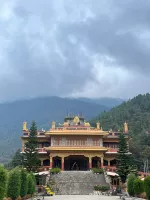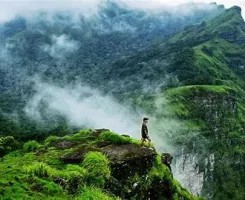Champaner Pavagadh Archaeological Park Travel Guide
Champaner Pavagadh Archaeological Park is a UNESCO World Heritage Site located in Gujarat, India. The park is known for its historical significance, dating back to the 8th century. It showcases a blend of Hindu and Islamic architectural styles, reflecting the region's cultural diversity. The park is famous for its well-preserved structures, including mosques, temples, tombs, and stepwells, offering a glimpse into India's rich heritage.Top Attractions in Champaner Pavagadh Archaeological Park
- Jami Masjid
- Kevda Masjid
- Sahar ki Masjid
- Helical Stepwell
- Kalika Mata Temple
Champaner Pavagadh Archaeological Park is Famous for
Its well-preserved blend of Hindu and Islamic architectural styles.Top Attractions in Champaner Pavagadh Archaeological Park
- Explore the Jami Masjid, a stunning mosque with intricate carvings.
- Visit the Kalika Mata Temple, dedicated to the Goddess Kali.
- Admire the Helical Stepwell, a unique architectural marvel.
- Discover the Sahar ki Masjid, known for its elegant design.
- Experience the spiritual ambiance of Kevda Masjid.
What's Great about Travelling to Champaner Pavagadh Archaeological Park?
- Rich historical and cultural experience
- Unique blend of architectural styles
- Serene and spiritual ambiance
What's Not So Great about Travelling Champaner Pavagadh Archaeological Park?
- Limited dining and accommodation options
- Extreme temperatures during summer
- May not be suitable for travelers with mobility issues
Travel Tips for Champaner Pavagadh Archaeological Park
- Carry sufficient water and sun protection
- Respect the religious sites and local customs
- Wear comfortable footwear for exploring the park
Important Champaner Pavagadh Archaeological Park trip information
- Ideal Duration: 1-2 days
- Best Time to Visit: October to March
- Nearby Airports and Railway Stations: Vadodara Airport and Vadodara Railway Station
Per Person
19,000
*EXCLUDING APPLICABLE TAXES 5.0 Ratings
( 8 Reviews )
( 8 Reviews )
Per Person
24,400
*EXCLUDING APPLICABLE TAXES Per Person
18,000
*EXCLUDING APPLICABLE TAXES Per Person
40,000
*EXCLUDING APPLICABLE TAXES Per Person
15,000
*EXCLUDING APPLICABLE TAXES Per Person
34,990
*EXCLUDING APPLICABLE TAXES FAQ's on Champaner Pavagadh Archaeological Park
Q1: What is the best time to visit Champaner Pavagadh Archaeological Park?
The best time to visit Champaner Pavagadh Archaeological Park is during the winter months from November to February when the weather is cool and pleasant for exploring the historical sites. Avoid the monsoon season from June to September as heavy rains can hinder outdoor activities. The park can get crowded during peak tourist seasons, so consider visiting during weekdays for a more relaxed experience.
Q2: Do I need a visa to travel to Champaner Pavagadh Archaeological Park?
Tourists visiting Champaner Pavagadh Archaeological Park will need a valid Indian visa. However, travelers from certain countries may be eligible for an e-Visa or visa on arrival. It is advisable to check with the Indian embassy or consulate in your country for specific visa requirements and to ensure compliance with all entry regulations.
Q3: What are the must-visit attractions in Champaner Pavagadh Archaeological Park?
Some of the must-visit attractions in Champaner Pavagadh Archaeological Park include the UNESCO World Heritage Site of Champaner, the Kalika Mata Temple, Lakulisa Temple, Jami Masjid, and the Pavagadh Fort. Visitors can explore the ancient ruins, stepwells, and intricately carved temples that showcase the rich history and architectural heritage of the region. Hiking up Pavagadh Hill to reach the temples offers breathtaking views of the surrounding landscape.
Q4: Is Champaner Pavagadh Archaeological Park a safe place to travel?
Champaner Pavagadh Archaeological Park is generally safe for tourists. However, it is recommended to take standard precautions such as safeguarding your belongings, avoiding isolated areas after dark, and being aware of your surroundings. Stay informed about any local advisories or safety concerns and follow the guidance of local authorities. Additionally, respect the cultural and religious sites to ensure a smooth and enjoyable visit.
Q5: What is the local currency in Champaner Pavagadh Archaeological Park and can I use credit cards?
The local currency in Champaner Pavagadh Archaeological Park is the Indian Rupee (INR). ATMs are available in nearby towns for cash withdrawals, and credit cards are accepted at some hotels, restaurants, and larger establishments. It is advisable to carry some cash for smaller vendors and local markets. Inform your bank about your travel plans to avoid any issues with card transactions.
Q6: What is the local cuisine like in Champaner Pavagadh Archaeological Park?
The local cuisine in Champaner Pavagadh Archaeological Park offers a flavorful mix of Gujarati and Indian dishes. Try traditional vegetarian thalis, dhokla, fafda, and Gujarati snacks for a taste of the regional flavors. Street food stalls offer delicacies like khaman, jalebi, and chaat. Be mindful of spice levels and hygiene standards when dining at local eateries. Vegetarian options are abundant, reflecting the cultural preferences of the region.
Q7: What transportation options are available in Champaner Pavagadh Archaeological Park?
Transportation options in Champaner Pavagadh Archaeological Park include taxis, auto-rickshaws, and buses for local travel. Hiring a private car or driver is convenient for exploring the park and nearby attractions. Public buses connect major towns in the region, but schedules may vary. Walking and hiking are popular ways to navigate the archaeological sites and nature trails. Consider renting a bicycle for a more eco-friendly and leisurely exploration of the area.
Q8: Are there any cultural norms or etiquette I should be aware of when visiting Champaner Pavagadh Archaeological Park?
When visiting Champaner Pavagadh Archaeological Park, it is important to respect local customs and traditions. Dress modestly when visiting religious sites, covering shoulders and knees. Remove shoes before entering temples and mosques as a sign of respect. Seek permission before taking photographs of locals or in sensitive areas. Greet people with a polite "Namaste" and show courtesy in interactions. Avoid public displays of affection and be mindful of cultural sensitivities. Learning a few basic phrases in Gujarati can enhance your travel experience and show appreciation for the local culture.
Q9: I am a travel agent. How can I buy travel leads of Champaner Pavagadh Archaeological Park?
Register yourself as a travel agent at agents.tripclap.com and then you can buy travel leads to Champaner Pavagadh Archaeological Park once your account is approved. For more details contact our support team at +91-8069186564 or support@tripclap.com






